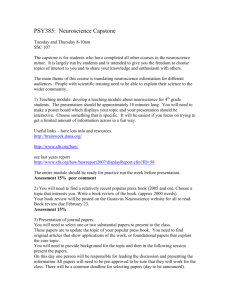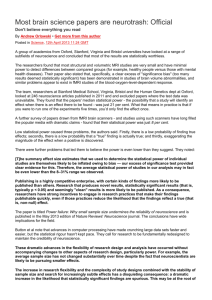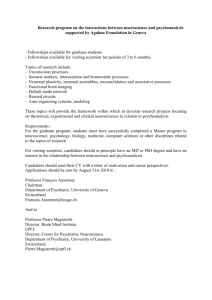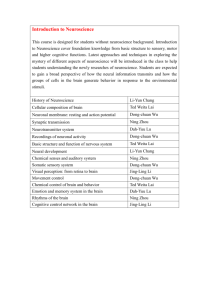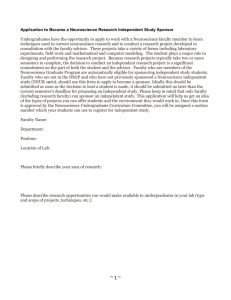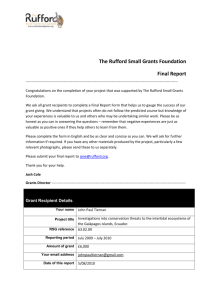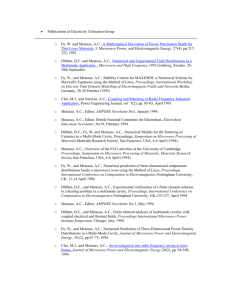Sophomore Early Research Program 2009-2010
advertisement
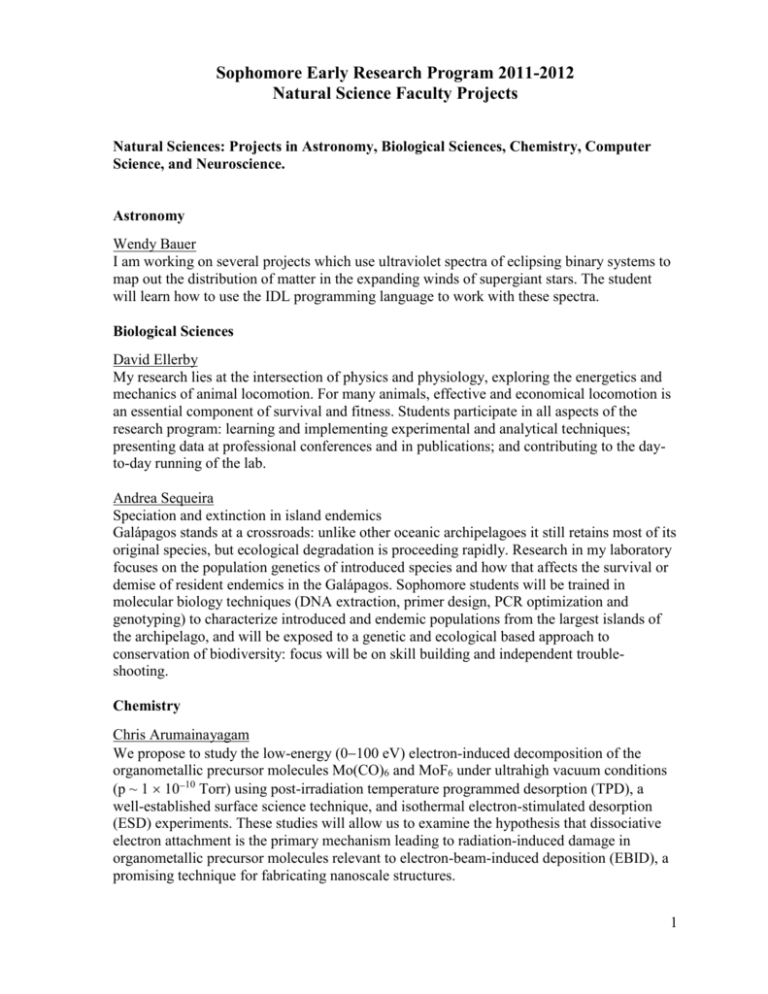
Sophomore Early Research Program 2011-2012 Natural Science Faculty Projects Natural Sciences: Projects in Astronomy, Biological Sciences, Chemistry, Computer Science, and Neuroscience. Astronomy Wendy Bauer I am working on several projects which use ultraviolet spectra of eclipsing binary systems to map out the distribution of matter in the expanding winds of supergiant stars. The student will learn how to use the IDL programming language to work with these spectra. Biological Sciences David Ellerby My research lies at the intersection of physics and physiology, exploring the energetics and mechanics of animal locomotion. For many animals, effective and economical locomotion is an essential component of survival and fitness. Students participate in all aspects of the research program: learning and implementing experimental and analytical techniques; presenting data at professional conferences and in publications; and contributing to the dayto-day running of the lab. Andrea Sequeira Speciation and extinction in island endemics Galápagos stands at a crossroads: unlike other oceanic archipelagoes it still retains most of its original species, but ecological degradation is proceeding rapidly. Research in my laboratory focuses on the population genetics of introduced species and how that affects the survival or demise of resident endemics in the Galápagos. Sophomore students will be trained in molecular biology techniques (DNA extraction, primer design, PCR optimization and genotyping) to characterize introduced and endemic populations from the largest islands of the archipelago, and will be exposed to a genetic and ecological based approach to conservation of biodiversity: focus will be on skill building and independent troubleshooting. Chemistry Chris Arumainayagam We propose to study the low-energy (0100 eV) electron-induced decomposition of the organometallic precursor molecules Mo(CO)6 and MoF6 under ultrahigh vacuum conditions (p ~ 1 1010 Torr) using post-irradiation temperature programmed desorption (TPD), a well-established surface science technique, and isothermal electron-stimulated desorption (ESD) experiments. These studies will allow us to examine the hypothesis that dissociative electron attachment is the primary mechanism leading to radiation-induced damage in organometallic precursor molecules relevant to electron-beam-induced deposition (EBID), a promising technique for fabricating nanoscale structures. 1 Don Elmore Students working in my research lab would learn to use experimental techniques and/or computational molecular modeling to investigate biochemical processes on a molecular level. In particular, student projects will study antimicrobial peptides, lipid-binding in the plant Patellin protein, or bacterial ion channels. Nolan Flynn The work study project focuses on making chemically-functionalized metallic nanoparticles. We will characterize these nanoparticles with a battery of analytical methods, including spectroscopies and electron microscopy. Following characterization, we will assemble the nanoparticles in aqueous solution using electrochemical methods. Adele Wolfson, (Biochemistry) The focus of research in my lab is enzyme mechanism and regulation. We study the enzyme thimet oligopeptidase (TOP) as a model of a metalloenzyme with a wide range of distribution and function. Right now we are particularly studying regulation of TOP in prostate cancer cells. Students working in my lab have the opportunity to interact with students and faculty in the chemistry department and biological chemistry and neuroscience programs, to learn techniques applicable to biochemistry and endocrinology, and see the connections to problems of medical relevance. Computer Science Panagiotis Metaxas Prof. Metaxas is working on projects related to the reliability of information on the Web and Online Social Networks. Students will get a better understanding on the issues addressed by his research, and help evaluate the quality of information that appears on twitter, facebook and the Web. The job does not require programming ability, though it would be a plus to have some experience in it. Neuroscience Bevil Conway A position for a Sophomore to conduct research as part of the SERP program is available in the Conway lab, in the Program in Neuroscience at Wellesley College. The student will help design and perform behavioral and psychophysical experiments aimed at uncovering the neural mechanisms of color perception. The lab uses psychophysical, electrophysiological and computational approaches, although no previous experience is necessary. The lab provides a supportive environment where all lab members are encouraged to participate in all aspects of the lab's intellectual life, including presenting at journal clubs and national conferences, making posters, and writing scientific papers. In addition, lab members are encouraged to further develop their interests through participation in the Wellesley College System's Club, a consortium of four labs spanning Psychology, Computer Science and Neuroscience that are bound by a common interest in system's-level methods and questions. Marc Tetel My lab is interested in how steroid hormones work in the brain to regulate gene expression and behavior. Students use a variety of techniques to investigate hormone function in brain, 2 including protein-protein interaction assays and confocal microscopy. In addition to learning these techniques and conducting experiments, students will assist in general lab maintenance and organization. Mike Wiest In the Wiest Lab we use surgically implanted arrays of tiny electrodes to record the electrical activities of neurons in rats’ brains while they engage in sensory detection tasks, to try to understand how the brain creates perceptions. The research student would be responsible for regular training of a group of rats, and if interested could also help with histological slicing and staining of brains, neural recordings and data analysis, implantation surgeries, and other lab activities. Potential educational benefits of this position include learning about animal behavior, behavioral neurophysiology, the technical computing language Matlab, histological techniques, surgical techniques, and modern approaches to the scientific study of mental functions like attention and consciousness. 3


